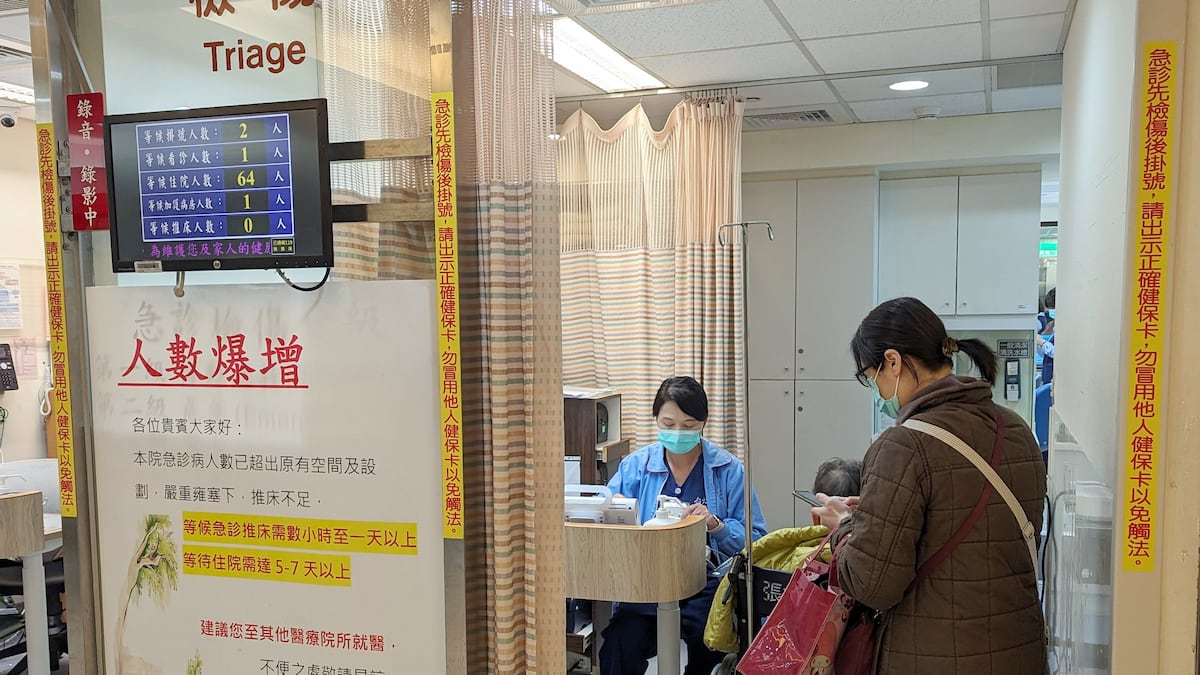The island of Taiwan has made headlines in recent days after a powerful earthquake, but the small Asian territory is also recognized as one of the best countries on the planet to seek emergency treatment in just a few minutes or get an appointment. you with the specialist of your choice, things practically impossible in Quebec.
Thanks to its efficiency, the Asian nation’s health system is often cited as an example to follow.
However, there is no shortage of needs on this island of 23 million inhabitants, faced like all developed economies with the aging of its population.
At National Taiwan University Hospital, located in the city center of the capital Taipei, around 300 people come to the emergency room every day. There were so many people that when the Newspapermany patients were placed on stretchers in the corridors.
Emergency rooms are very busy in Taiwan, so many patients have to be placed in corridors, like in Quebec. The difference is that they are seen by a doctor in less than an hour.
Special collaboration photo Rémy Bourdillon
However, no long wait here.
Not so different from Quebec
Surprisingly, the Taiwanese system is not that different from that of Quebec. Before creating its health insurance scheme, the National Health Insurance (NHI), in 1995, the island’s government sent observers to several countries, just to arrive at the best possible assembly. From Canada, it retained the “single payer” system: thus, like the RAMQ, the NHI is a public insurer which covers the entire population of Taiwan – but more broadly, since even dental care and Chinese medicine are included.
The big difference is that patients are completely free to consult publicly or privately, without the second option costing them more. From countless neighborhood clinics to state-of-the-art megahospitals, they can go where it is most convenient for them – and therefore do not systematically end up in emergency rooms. They can even decide to make an appointment directly with any specialist, for example one recommended to them by a friend.

A typical neighborhood clinic in Taiwan. Some are barely the size of a boutique.
Special collaboration photo Rémy Bourdillon
To attract patients to their establishment and serve them as quickly as possible, doctors work at a hellish pace.
The service is not free: you have to pay a small amount of money each time to get treatment (for example, count the equivalent of $18 to consult a dermatologist in a regional hospital). For the director of the NHI, Chung-Liang Shih, this is necessary because access to care is so easy that, “if everything were free, everyone would want to benefit from it, even when it is superfluous”.

The director of National Health Insurance (NHI), the equivalent of our RAMQ, Chung-Liang Shih.
Special collaboration photo Rémy Bourdillon
This does not bother the Taiwanese, 91% of whom are satisfied with their healthcare system, according to a recent survey conducted by the NHI.
In Taiwan, there is a very dense network of small neighborhood clinics operated by general practitioners or specialists, public hospitals, and also private hospitals. As the law prohibits making a profit from health, these establishments belong, among others, to religious communities, private universities or philanthropic foundations financed by billionaire companies.
Fierce competition
This competition gives great choice to patients, who are completely free to decide where they will seek treatment.
To encourage them to turn to a small clinic rather than a hospital environment (and therefore relieve emergencies), the amount charged to them for each consultation is modulated. Thus, it costs only about CA$6 for each visit in a neighborhood clinic, but up to $40 in the emergency room of a large hospital. This price is the same, whether the establishment is public or private, and some amenities are provided for the less fortunate. The remainder of the bill is sent by the medical facility to the NHI.
For its part, the government stands out for its extremely rigorous control of health system spending: the latter only represents 6.6% of Taiwanese GDP (compared to 12.2% in Canada) and its budget has never increased by more than 6% in recent years.

Patients wait to checkout to pay their co-payments at Taiwan University Hospital. These costs are generally higher in a hospital emergency room than in neighborhood clinics.
Special collaboration photo Rémy Bourdillon
Each year, a committee sets the NHI budget for the following year, and therefore the value of the premiums paid monthly by the population (equivalent to 5.17% of the salary of each citizen in 2024). Healthcare providers, both public and private, compete to get shares of this budget. Each medical procedure is assigned a certain number of points, and the predetermined budget is divided by the total number of points distributed in the year to determine how much each hospital or clinic will receive.
Committee: around thirty members from three categories:
- Care providers
- Taxpayers (representatives of unions, associations and SMEs)
- Government and experts
For an employee, the premium (currently 5.17%) is paid as follows: 30% by the worker, 60% by the employer and 10% by the government.
This method pushes healthcare establishments to always treat more patients than their competitors to maintain their profitability. And patients benefit from this, Professor Yeh thinks: “To attract them, hospitals and clinics tend to improve their comfort or open in the evening.”

